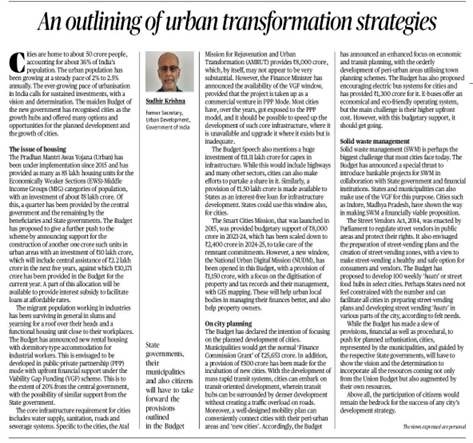Urban Transformation in India: A Strategic Overview
Important Points:
- The importance of public-private partnerships in financing urban development projects.
- The role of technology in improving urban governance and service delivery.
- The need for capacity building of urban local bodies.
- The potential of urban agriculture and green spaces in enhancing city liveability
Introduction
- India is undergoing a rapid urbanization process, with its urban population growing at a steady pace of 2-2.5% annually.
- This burgeoning urban landscape necessitates a strategic approach to address the challenges and harness the opportunities it presents.
- The recent Union Budget has recognized the pivotal role of cities in driving economic growth and has outlined several initiatives to foster their development.
Key Challenges
- Rapid Urbanization: The pace of urbanization has outstripped infrastructure development, leading to issues such as housing shortages, traffic congestion, and environmental degradation.
- Slum Dwellings: A significant portion of the urban population resides in slums, lacking basic amenities and security.
- Infrastructure Deficiencies: Cities grapple with inadequate water supply, sanitation, roads, and sewerage systems.
- Solid Waste Management: The efficient disposal of solid waste remains a major challenge for most urban areas.
Government Initiatives – The government has introduced several schemes and policies to address these challenges:
Housing
- Pradhan Mantri Awas Yojana (Urban): Aims to provide affordable housing to the economically weaker sections and middle-income groups. The budget has allocated ₹10 lakh crore for constructing an additional one crore housing units.
- Rental Housing: The government is promoting the development of rental housing for industrial workers through public-private partnerships.
Infrastructure
- Atal Mission for Rejuvenation and Urban Transformation (AMRUT): Focuses on improving water supply, sewerage, and urban transport.
- National Urban Digital Mission (NUDM): Aims to digitize property and tax records for better financial management.
- Infrastructure Financing: The budget has allocated substantial funds for infrastructure development, including interest-free loans to states.
Urban Planning
Emphasis on Economic and Transit Planning: The government is promoting the orderly development of peri-urban areas and encouraging electric bus systems.
Street Vendors: The budget proposes developing 100 weekly street food hubs and emphasizes the importance of street-vending plans.
Case Study: Indore
Indore has emerged as a model city in solid waste management, demonstrating that such challenges can be transformed into opportunities. The city’s success can be replicated in other urban areas.
Conclusion
The government’s focus on urban transformation is a positive step towards addressing the challenges posed by rapid urbanization. However, successful implementation requires strong collaboration between the central and state governments, local bodies, and citizens. By leveraging available resources and adopting innovative approaches, India can create sustainable and liveable cities.
Urban Transformation in India: A Strategic Overview
Important Points:
- The importance of public-private partnerships in financing urban development projects.
- The role of technology in improving urban governance and service delivery.
- The need for capacity building of urban local bodies.
- The potential of urban agriculture and green spaces in enhancing city liveability
Introduction
- India is undergoing a rapid urbanization process, with its urban population growing at a steady pace of 2-2.5% annually.
- This burgeoning urban landscape necessitates a strategic approach to address the challenges and harness the opportunities it presents.
- The recent Union Budget has recognized the pivotal role of cities in driving economic growth and has outlined several initiatives to foster their development.
Key Challenges
- Rapid Urbanization: The pace of urbanization has outstripped infrastructure development, leading to issues such as housing shortages, traffic congestion, and environmental degradation.
- Slum Dwellings: A significant portion of the urban population resides in slums, lacking basic amenities and security.
- Infrastructure Deficiencies: Cities grapple with inadequate water supply, sanitation, roads, and sewerage systems.
- Solid Waste Management: The efficient disposal of solid waste remains a major challenge for most urban areas.
Government Initiatives – The government has introduced several schemes and policies to address these challenges:
Housing
- Pradhan Mantri Awas Yojana (Urban): Aims to provide affordable housing to the economically weaker sections and middle-income groups. The budget has allocated ₹10 lakh crore for constructing an additional one crore housing units.
- Rental Housing: The government is promoting the development of rental housing for industrial workers through public-private partnerships.
Infrastructure
- Atal Mission for Rejuvenation and Urban Transformation (AMRUT): Focuses on improving water supply, sewerage, and urban transport.
- National Urban Digital Mission (NUDM): Aims to digitize property and tax records for better financial management.
- Infrastructure Financing: The budget has allocated substantial funds for infrastructure development, including interest-free loans to states.
Urban Planning
Emphasis on Economic and Transit Planning: The government is promoting the orderly development of peri-urban areas and encouraging electric bus systems.
Street Vendors: The budget proposes developing 100 weekly street food hubs and emphasizes the importance of street-vending plans.
Case Study: Indore
Indore has emerged as a model city in solid waste management, demonstrating that such challenges can be transformed into opportunities. The city’s success can be replicated in other urban areas.
Conclusion
The government’s focus on urban transformation is a positive step towards addressing the challenges posed by rapid urbanization. However, successful implementation requires strong collaboration between the central and state governments, local bodies, and citizens. By leveraging available resources and adopting innovative approaches, India can create sustainable and liveable cities.


